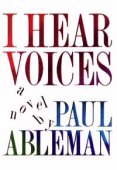Book Review: Paul Ableman's I Hear Voices
reviewed by anna battista

“It is time that serious notice was taken of Paul Ableman,” Anthony Burgess, said a while back. More famous for being a playwright - the world premier of Green Julia, his first play, took place at the 1965 Edinburgh Festival - and the author of many television scripts, Paul Ableman (born in 1927 in Leeds and currently living in London), has also been chief fiction reviewer for The Spectator and The Evening Standard, and the author of controversial non-fiction books such as The Mouth and Oral Sex, and of the novels I Hear Voices, VacTornado Pratt and Twilight of the Vilp.
I Hear Voices was first published in 1958 by Olympia Press, a Paris-based publishing house founded in 1935 and directed by Maurice Girodias, and was later released in 1977 in Great Britain. Olympia Press’ aim was to publish English texts which were subjected to be banned if published in Britain or in the States. Girodias’ publishing house first concentrated on publishing erotica books such as Marquis De Sade's La Philosophie dans le Boudoir (The Bedroom Philosophers), Guillaume Apollinaire's Mémoirs d'un Jeune Don Juan (Memoirs of a Young Rakehell), Georges Bataille's L'Histoire de L'Oeil (A Tale of Satisfied Desire), but then started featuring in its catalogues also more experimental books such as Beckett’s Watt. Ableman’s book can be categorised as one of the experimental Olympia volumes. The book tells the story of Arthur, a schizophrenic man confined to a hospital bed. Arthur’s mind is a broken shell, untouched by logic and intellectually deteriorated, penetrated by the reality and by the sounds and voices of the outside world. Arthur is isolated in his condition, yet the careful reader will be able to reach him, empathize with him and follow the voyages of his tortured and wandering mind.
From its very first page with a quote by a schizophrenic that states, “Until, gentlemen, you decide further what my occupation is, you may as well announce me as comforting 35 whirlpools below sound,” the reader will soon understand that this story is written in a challenging style: the dust jacket of the first Olympia Edition states, “the form of his style and the purpose of his book may be what all contemporary literature has been aiming at, since the conventional novel has begun to dissolve … Ableman has progressed very far along the same path as Dostoevsky, Kafka, Joyce and Beckett.” In a way the language of I Hear Voices owes more to poetry than to prose and is every now and then reminiscent of the best William Burroughs for its fragmentary cut-up like scenes (“Wonderingly I touch the white sheet and thin ridges of my breast. I am here. This is No. 75, Walpole Avenue and my name is—this is No. 75, Walpole—and I am certainly here—no dates, I don't really need them even at moments like these—but this is my real home and Arthur and Cousin Susan and the rest are about.”). Syntax and grammar are efficiently used in the novel to capture the echoes and voices of the fragmentary universe of Ableman’s characters.
Though Ableman focused on the relationship language-mind also in the essay The Secret of Consciousness, in which he also analysed the malfunctioning mind as manifested in schizophrenia, sleepwalking, autism, 'out of body' experiences and nightmares, it is I Hear Voices that will remain the best book about such topics, a mesmerizing book that has exerted influence on many contemporary authors.
Paul Ableman's I Hear Voices has just been released for the first time in the States by McPherson & Company.
{a href="http://www.mcphersonco.com">www.mcphersonco.com}
Copyright (c) 2005 erasing clouds |
|